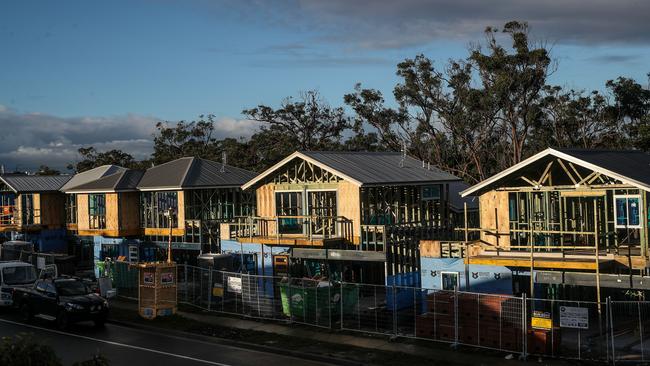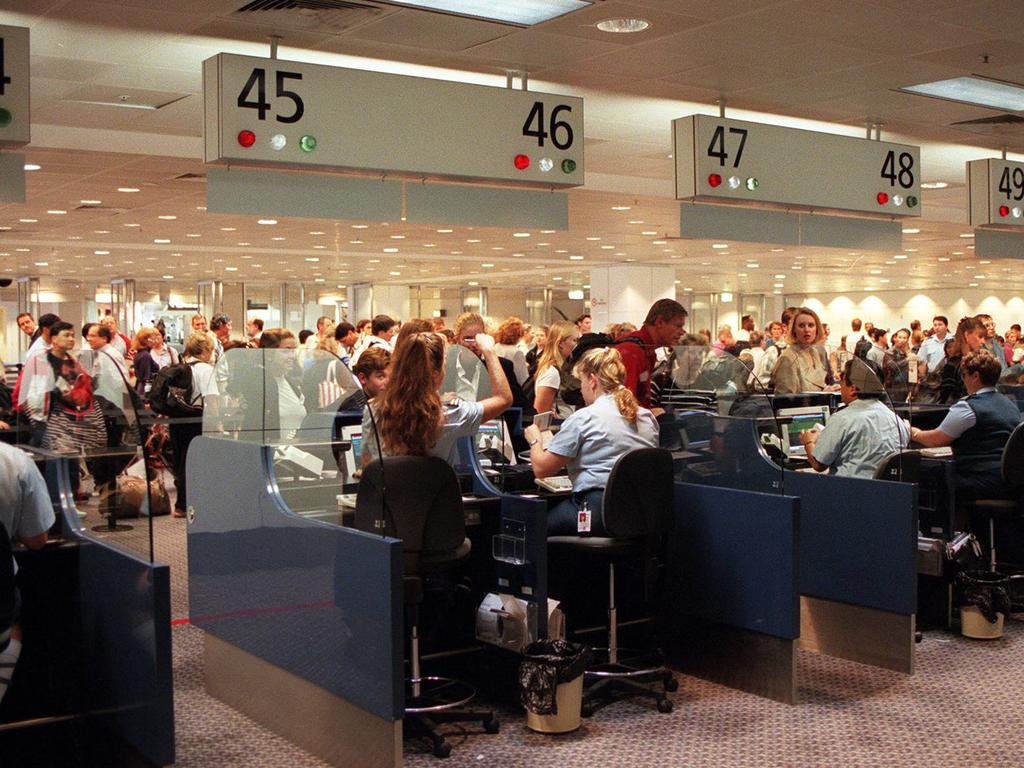Don’t blame migrants for housing and living cost crises
For decades, the nation hasn’t built enough homes and our young people are paying the price for this collective failure.

It’s a temporary surge, not an enduring calamity, although mismanagement of population again threatens the quiet genius of our prosperity and tolerance, stokes populist responses, and highlights the woeful decades-long performance – across three tiers of government – to build homes.
The migrant inflow has kept the consumer economy ticking over amid the living cost crisis and also added a mammoth amount to the nation’s service export earnings. Migration has also increased labour supply at a time of acute shortages, although not nearly by enough in industries such as construction, where the needs are seemingly insatiable.
According to the Department of Home Affairs, there were 1.7 million temporary visa holders in Australia with work rights at the end of July (not counting 717,000 New Zealand citizens). Before the pandemic, five years ago this month, there were 1.25 million here on such visas, including bridging, student, working holiday maker, temporary employment and graduate.
The big leap in numbers comes from foreigners who have completed their studies, short-stay workers, students and those awaiting a decision on another visa, with roughly 100,000 more people in each of these categories than in September 2019.
“They’re just not going home,” one senior Canberra figure tells Inquirer of foreigners on temporary visas. “But with the end of pandemic-era work visas, clampdown on education providers, new international student caps and other changes, the migration numbers will return to more normal rates.”
And yet, new figures show there has been only a modest slowdown from last year’s record rates. On Thursday, the Australian Bureau of Statistics reported net overseas migration (NOM) was 510,000 in the year to March, not far below the high of 560,000 in the year to last September.
Numbers matter for the Albanese government, and not least because it continues to be exposed to the charge by its political opponents and their surrogates that it is running a “Big Australia policy by stealth” and “has lost control of our borders”.
In May last year, in his second budget, Jim Chalmers stood behind a NOM forecast of 315,000 for 2023-24. By December’s mid-year review, the forecast increased to 375,000. In this year’s budget, with less than seven weeks before the end the financial year, it was revised up to 395,000. The latest figures suggest NOM for 2023-24 is likely to be almost 100,000 above May’s estimate.
Don’t fall for the mischief makers who allege Treasury’s forecasts, as mistaken as they’ve been, are “targets”; they are not. Australia has planning levels for the permanent migration program with an intake of 190,000 last financial year and 185,000 this year.
Peter Dutton has pledged to cut by one-quarter, or to 140,000, the permanent program (where the government aims to have 70 per cent of places for skilled migrants). That won’t bring us tradies to build houses or innovators who bring fresh ideas and want to settle here and prosper.
Two-thirds of today’s inflow is due to demand-driven temporary migration. Still, it’s a bureaucratic, forecasting and planning failure of enormous magnitude. Labor delayed the release of its migration strategy until it was satisfied its ad hoc tweaks would lead to a halving in the migrant inflow from its peak last year to mid next year. Getting there will be a close-run thing.
Student visa refusal rates began rising last year due to vigilance for applicants from countries deemed a risk. Treasury secretary Steven Kennedy told the Senate in June fewer arrivals were expected, “in part due to the government’s actions to improve the integrity of international education”.
Just to be sure, Labor last month announced the number of foreigners starting their studies here next year would be cut to 270,000 (or 53,000 fewer than the 2023 enrolment). The bulk of the cuts would affect the most prestigious universities, which dominate the foreign student market.
Business Council of Australia president Geoff Culbert told the lobby’s annual dinner this week that while it may be popular to bash big business, “we are making success taboo in this country – and that is not consequence free”.
Culbert then highlighted the performance of the big exporters. “Over the past two decades, our university sector has built a product that is truly world-class and is now our second-biggest export market behind mining and resources. But rather than celebrate that success and support our most globally competitive industries, we seek to slow them down.”
There is a cost to locals of rapid migration, with inner-city housing an early stress point. According to the federal Department of Education, foreign students occupy 7 per cent of rental housing, a figure at odds with the education lobby’s 4 per cent estimate. Based on the cut-down quota, officials said 135,000 new international students would enter the private rental market next year.
The Education Department analysis links the student-led population boom to steep capital city rent hikes. The asking price of median rents for units have increased by 43 per cent in Sydney’s CBD since 2019 (asking rents fell during the pandemic; taken from the plateau of 2021, the rise in rents is 71 per cent). In Melbourne city, the increase over the five-year period has been 19 per cent.
The Reserve Bank has calculated that advertised rents are falling but it will take some time for this to feed into measured inflation – the nation’s number one economic problem, destroyer of household budgets and consumer mood. Michele Bullock says the main drivers of elevated inflation at the moment are housing costs and market services inflation.
Last month, while speaking in Armidale, the RBA governor was asked whether the rapid increase in migration had boosted inflation. “It’s probably been a net wash,” she said, meaning very little, if no, change due to the influx.
“The reason I say that is because yes migrants come in and they spend, but they also add to the supply side of the economy and coming out of the pandemic, some of you may remember, labour shortages were rife. We just didn’t have people to do the jobs. So they’ve added to the supply side of the economy as well.”
But, she added, the population boom has shown up in the capital stock and the housing stock. “The housing supply is a very slow moving thing and when you get a big increase in demand, which you do with migration, you end up obviously with pressure on housing prices and rents,” Bullock said.
Australians are “super-size me” when it comes to consuming housing. Another senior Canberra figure, echoing comments by the RBA chief, says the long-term decline in household size over several decades and the post-pandemic shift to working from home are important factors adding to demand. “That’s making the housing supply story a lot, lot worse,” the source tells Inquirer.
Over the past four decades, the number of people per dwelling has fallen from 3 to 2.5, implying an extra 2.2 million homes are needed to house the same population. During the pandemic, as grown children returned home and many did not leave the nest to study in cities, average household size rose to 2.55. Working from home likely made the average drop to 2.48, meaning an extra 275,000 homes are needed to house the same population.
Migration is a factor, of course, in the housing affordability crisis, but Labor argues it’s not playing the major role. As has been said over and over, the answer is more supply, supply, supply. It’s been a collective, national failure.
Over many years, we haven’t been building enough units and houses; state governments have gone missing on land supply; materials and labour costs have been rising post-pandemic at rates that have sent home-builders broke; approvals take too long; zoning laws, NIMBYs and the Greens in parliament are not helping; “big builds” in the states have sucked up tradies; construction industry productivity is abysmal; new energy rating regulations and other newish building codes are slowing down delivery and making homes needlessly more expensive.
Migration policy can help, and not just through better planning of the intake to manage the numbers over longer time horizons, of five or 10 years. The NSW Productivity and Equality Commission recently set out a reform road map to support homebuilding in the state. Among its recommendations was a shift in migration settings to support the construction industry. Over a decade, only 6 per cent of 700,000 skilled migrants had construction skills.
“Governments should shift the overseas migration intake to support construction and grow the local construction workforce,” the report said, noting a NSW shortfall of 30,000 construction workers to deliver the National Housing Accord. “Overseas construction qualifications should be better recognised in the visa process, migrants should be able to quickly put their skills to work, and barriers to interstate mobility should be better addressed.”
Labor’s target of 1.2 million new homes over five years won’t to be achieved unless there’s a revolution in policy and political will.
Perhaps hitting rock bottom on home affordability will force a dozen helpful policies and maybe better co-ordination between governments. Yes, the migrant intake is too high. But that, too, shall pass. Any leader who can break the miserable cycle in housing, and not just punch down on foreigners, will reap the electoral benefits.







Australia’s policy elite have been utterly caught out by the post-pandemic population boom. Foreign students, backpackers and workers have kept coming in record numbers and staying for longer than officials expected, putting more strain on housing, social services and transport.